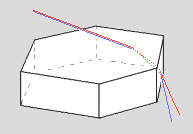Circumzenithal Arc
The Enchanting Circumzenithal Arc: A Delightful Atmospheric Phenomenon
Have you ever gazed up at the sky and been captivated by the sight of a vibrant, ethereal arc that seems to defy gravity? If so, you may have witnessed the mesmerizing spectacle known as the Circumzenithal Arc (CZA). This awe-inspiring optical phenomenon occurs when sunlight interacts with oriented plate crystals in the atmosphere, creating a breathtaking display of prismatic colors. In this article, we will delve into the intricate details of the CZA and explore the fascinating science behind its formation.
The Formation of the Circumzenithal Arc
The CZA owes its existence to the same oriented plate crystals that give rise to another well-known atmospheric phenomenon called sundogs. When sunlight enters the uppermost horizontal face of these crystals and exits through a vertical side face, a mesmerizing refraction process takes place. The nearly parallel rays of light pass through faces inclined at 90 degrees, resulting in the production of pure and well-separated prismatic colors. In fact, the colors observed in the CZA are even purer than those seen in a rainbow.
The Role of Sun Position
The position of the sun in relation to the observer plays a crucial role in determining whether the CZA is visible. When the sun is positioned higher than approximately 32.3 degrees, the rays of light are unable to leave through the side face of the crystals. Instead, they undergo total internal reflection and eventually emerge through the lower horizontal face. These rays then contribute to the formation of another captivating phenomenon known as the parhelic circle, which is characterized by its lack of color.
Parry Oriented Columns and the CZA
While oriented plate crystals are primarily responsible for the formation of the CZA, Parry oriented columns also play a role in this captivating atmospheric display. These column-shaped ice crystals can contribute to the appearance of the CZA under certain conditions. When sunlight interacts with Parry oriented columns, a similar refraction process occurs, resulting in the creation of the enchanting arc overhead.
The Smudge Effect
As the sun's altitude approaches the critical angle of 32 degrees, an intriguing phenomenon known as the "smudge effect" can be observed. At this specific solar altitude, the rays of sunlight just graze out of the vertical sides of plate-oriented crystals, leading to a smudged appearance of color directly overhead. This unique effect adds an extra layer of wonder to the already captivating CZA.
Appreciating the Circumzenithal Arc
To fully appreciate the beauty of the Circumzenithal Arc, it is important to observe it under optimal atmospheric conditions. Ideally, the sky should be relatively clear with minimal cloud cover. Additionally, the sun's position should be lower than 32.3 degrees to ensure that the rays of light can exit through the side faces of the crystals and form the distinct arc shape. Patience and a keen eye are key when searching for this ethereal phenomenon, as it may appear and disappear relatively quickly.
Similar Optical Phenomena
While the Circumzenithal Arc is undoubtedly a stunning sight to behold, it is not the only atmospheric phenomenon that showcases the wonders of light refraction. Here are a few other related optical phenomena that you might encounter:
-
Sundogs: These colorful patches of light often appear on either side of the sun and are caused by the interaction of sunlight with oriented plate crystals.
-
Rainbows: One of nature's most beloved spectacles, rainbows are formed when sunlight is refracted, reflected, and dispersed by raindrops in the atmosphere.
-
Halos: These luminous rings or arcs around the sun or moon are created when light is refracted by ice crystals in the atmosphere.
-
Sun Pillar: A vertical shaft of light extending above or below the sun, caused by the reflection of sunlight by ice crystals.
Capturing the Magic
If you're lucky enough to witness the enchanting Circumzenithal Arc, consider capturing its ephemeral beauty through photography. A wide-angle lens and a polarizing filter can help enhance the colors and details of this celestial display. Experiment with different angles and compositions to truly convey the awe-inspiring nature of this optical phenomenon.
In conclusion, the Circumzenithal Arc is a remarkable atmospheric spectacle that showcases the intricate interplay between sunlight and oriented plate crystals. Its vibrant prismatic colors and captivating arc shape make it a delight to behold for those fortunate enough to witness it. So, the next time you find yourself gazing up at the sky, remember to keep an eye out for this elusive and enchanting phenomenon that reminds us of the boundless wonders of our natural world.

The CZA is produced by oriented plate crystals, the same crystals that form sundogs.
Downcoming sunrays enter the uppermost horizontal face and leave through a vertical side face.
The refraction of rays nearly parallel rays through faces inclined at 90� produces very pure and well separated prismatic colours. The colours of the circumzenithal arc are purer than those of the rainbow.
When the sun is higher than about 32.3�, the rays cannot leave the side face but are instead totally internally reflected. They then eventually emerge through the lower horizontal face to contribute to the almost devoid of colour parhelic circle.
The arc is also formed by Parry oriented columns .

Smudge on the sky. Near the critical solar altitude of 32�, rays just graze out of the vertical sides of plate oriented crystals. The result - a smudge of colour almost directly overhead.
Note: this article has been automatically converted from the old site and may not appear as intended. You can find the original article here.
Reference Atmospheric Optics
If you use any of the definitions, information, or data presented on Atmospheric Optics, please copy the link or reference below to properly credit us as the reference source. Thank you!
-
<a href="https://atoptics.co.uk/blog/circumzenithal-arc-2/">Circumzenithal Arc</a>
-
"Circumzenithal Arc". Atmospheric Optics. Accessed on December 22, 2024. https://atoptics.co.uk/blog/circumzenithal-arc-2/.
-
"Circumzenithal Arc". Atmospheric Optics, https://atoptics.co.uk/blog/circumzenithal-arc-2/. Accessed 22 December, 2024
-
Circumzenithal Arc. Atmospheric Optics. Retrieved from https://atoptics.co.uk/blog/circumzenithal-arc-2/.